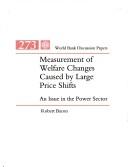| Listing 1 - 10 of 77 | << page >> |
Sort by
|
Book
ISBN: 0197300103 Year: 1990 Publisher: Oxford Oxford University Press
Abstract | Keywords | Export | Availability | Bookmark
 Loading...
Loading...Choose an application
- Reference Manager
- EndNote
- RefWorks (Direct export to RefWorks)
Foreign trade policy --- Europe --- AA / International- internationaal --- EUR / Europe - Europa --- 338.731 --- Aardolie. Aardolieschok. --- Petroleum industry and trade --- Petroleum refineries --- Aardolie. Aardolieschok

ISBN: 0198772777 Year: 1988 Publisher: Oxford Oxford University Press
Abstract | Keywords | Export | Availability | Bookmark
 Loading...
Loading...Choose an application
- Reference Manager
- EndNote
- RefWorks (Direct export to RefWorks)
Econometrics --- 330.115 --- 330.115 Econometrie --- Econometrie --- Economics, Mathematical --- Statistics --- Quantitative methods (economics)

ISBN: 0821331558 Year: 1995 Publisher: Washington, D.C. World Bank
Abstract | Keywords | Export | Availability | Bookmark
 Loading...
Loading...Choose an application
- Reference Manager
- EndNote
- RefWorks (Direct export to RefWorks)
Book
Year: 1915 Volume: 8 Publisher: Washington : Fundacion Carnegie,
Abstract | Keywords | Export | Availability | Bookmark
 Loading...
Loading...Choose an application
- Reference Manager
- EndNote
- RefWorks (Direct export to RefWorks)
Book
Year: 1646 Publisher: London : Printed by R.L. for Giles Calvert ...,
Abstract | Keywords | Export | Availability | Bookmark
 Loading...
Loading...Choose an application
- Reference Manager
- EndNote
- RefWorks (Direct export to RefWorks)
On the action by the city of Gloucester in suppressing his preaching and expelling him from the city. eebo-0160
Book
Year: 2018 Publisher: Washington, D.C. : The World Bank,
Abstract | Keywords | Export | Availability | Bookmark
 Loading...
Loading...Choose an application
- Reference Manager
- EndNote
- RefWorks (Direct export to RefWorks)
This paper reviews recent literature on the impacts of various components of power sector reform on the performance of electric utilities in developing countries. Recent literature is heavily focused on statistical testing of the significance of the links between four components of sector reform (unbundling, private sector participation, regulation, and competition) and various performance indicators (relating to utility performance, user outcomes, and broader economic development). Some studies exhibit methodological shortcomings in failing to account for interactions between reforms or degrees of reform; however, others appear to be robust. The strongest result is that the introduction of private sector participation is linked to a significant improvement in labor productivity and distribution losses. Moreover, unbundling reforms in isolation is found to have hardly any significant impact on utility performance. The introduction of an independent regulator or competition is not generally significant across studies. A notable feature of all of the studies is very limited testing of the effects of policy introduction on performance indicators, such as bill collection and the duration and frequency of outages. Poor performance on these indicators of state-owned power companies is well documented and bill collection has been identified as a major hidden cost of unreformed power sectors. The materiality of the impact of private sector participation, on the various performance indictors found to be significant, is calculated for studies that provide sufficient information to do so. The size of the impact of private sector participation on utility performance is substantial in a couple of studies, although much more modest in others.
Competition --- De Facto Governments --- Democratic Government --- Developing Countries --- Electric Utilities --- Emerging Markets --- Energy --- Energy and Environment --- Energy Demand --- Energy Policies and Economics --- Energy Privatization --- Energy Sector Regulation --- Governance --- Private Sector Development --- Privatization --- Public Sector Development --- Regulation --- Restructuring
Book
Year: 1652 Publisher: London : Printed for Giles Calvert, and are to be sold at his shop at the sign of the black spread Eagle, at the West end of Pauls,
Abstract | Keywords | Export | Availability | Bookmark
 Loading...
Loading...Choose an application
- Reference Manager
- EndNote
- RefWorks (Direct export to RefWorks)
eebo-0018
Clergy --- Missionaries --- Church of England
Book
Year: 1649 Publisher: London : [s.n.],
Abstract | Keywords | Export | Availability | Bookmark
 Loading...
Loading...Choose an application
- Reference Manager
- EndNote
- RefWorks (Direct export to RefWorks)
eebo-0018
Great Britain --- History --- Religion
Book
Year: 2016 Publisher: Washington, District of Columbia : World Bank,
Abstract | Keywords | Export | Availability | Bookmark
 Loading...
Loading...Choose an application
- Reference Manager
- EndNote
- RefWorks (Direct export to RefWorks)
Analysis of household expenditure surveys since 2008 in 22 Sub-Saharan African countries shows that one-third of all people use electricity. As expected, users are disproportionately urban and rich. In communities with access to electricity, lack of affordability is the greatest barrier to household connection. Lifeline rates enabling the poor to use grid electricity vary in availability, with six countries allowing 30 kilowatt-hours or less of electricity usage a month at low prices. Affordability challenges are aggravated by sharing of meters by several households -- denying them access to lifeline rates -- and high connection costs in many countries, made worse by demands from utility staff for bribes in some countries. Collection of detailed information on residential schedules enabled calculation of the percentage of total household expenditures needed for electricity at the subsistence and other levels. Affordability varied across countries, with grid electricity even at the subsistence level being out of reach for the poor in half the countries and even more so once connection charges are considered. Examination of the gender of the head of household shows that female-headed households are not disadvantaged in electricity use once income and the place of residence (urban or rural) are taken into account. However, female-headed households tend to be poorer, making it all the more important to focus on helping the poor for the goal of achieving universal access. Installing individual meters and subsidizing installation, encouraging prepaid metering so as to avoid disconnection and reconnection charges, reformulating lifeline blocks and rates as appropriate, and stamping out corruption to eliminate bribe-taking can all help the poor.
Book
ISBN: 1280017015 9786610017010 0585264805 Year: 1995 Publisher: Washington, D.C. : World Bank,
Abstract | Keywords | Export | Availability | Bookmark
 Loading...
Loading...Choose an application
- Reference Manager
- EndNote
- RefWorks (Direct export to RefWorks)
Electric Utilities --- Welfare economics --- Mathematical models --- Rates --- Electric utilities --- Mathematical models.
| Listing 1 - 10 of 77 | << page >> |
Sort by
|

 Search
Search Feedback
Feedback About UniCat
About UniCat  Help
Help News
News